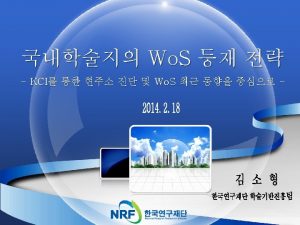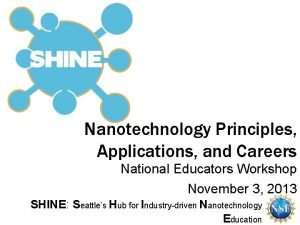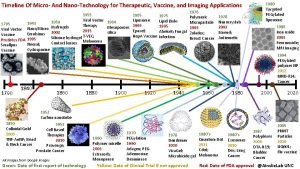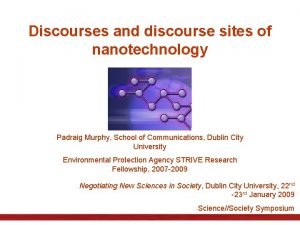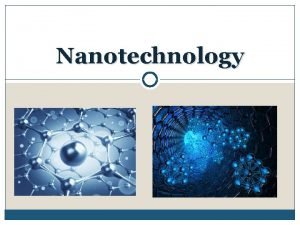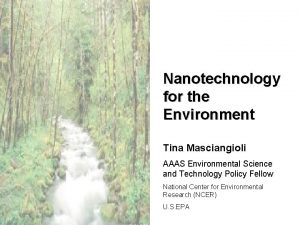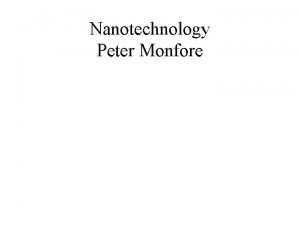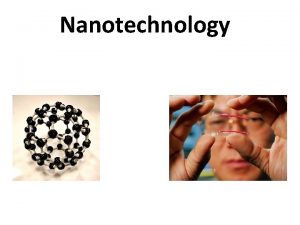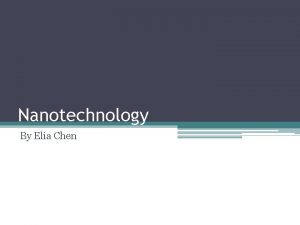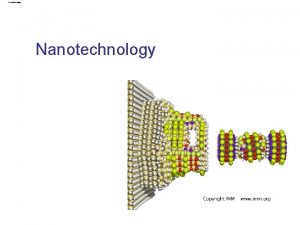Nanotechnology for the Environment Tina Masciangioli AAAS Environmental










- Slides: 10

Nanotechnology for the Environment Tina Masciangioli AAAS Environmental Science and Technology Policy Fellow National Center for Environmental Research (NCER) U. S. EPA

Nanotechnology and the Environment The bad… Nature of nanoparticles themselves. Characteristics of the products made. Manufacturing processes involved. • As nano-xyz is manufactured, what materials are used? • What waste is produced? • Are toxic substances used in the manufacturing of nano-xyz? • What happens when nano-xyz gets into the air, soil, water, or biota? “The emerging fields of nanoscience and nanoengineering are leading to unprecedented understanding and control over the fundamental building blocks of all physical things. This is likely to change the way almost everything - from vaccines to computers to automobile tires to objects not yet imagined - is designed and made. ” - Interagency Working Group on Nanoscience, Engineering, and Technology Report (1999)

Avoiding the Negative Are there more benign precursor materials or synthetic methods that can be used to make the quantum dots? Will it be possible to recover the quantum dots for reuse? How are these semiconductor nanoparticles being introduced to their target? Cadmium sulfide (Cd. S) “Quantum dots” H 2 S gas + Cd. S Cd(CH 3)2 Enter the environment Cd. S Bio/Enviro/other applications Are there measures that can be taken now to minimize or avoid the negative impact quantum dots (or other nanotechnologies) may have on the environment?

Nanotechnology and the Environment “As EPA looks to the future, it will need to employ innovative approaches and sound science to investigate complex, interdisciplinary problems in environmental protection. ” - EPA FY 2001 Annual Report The good… Nanotechnology has the potential to substantially benefit environmental quality and sustainability through • Pollution prevention • Treatment • Remediation • Information

Nanotechnology for pollution prevention Synthetic or manufacturing processes which can occur at ambient temperature and pressure. Use of non-toxic catalysts with minimal production of resultant pollutants. Use of aqueous-based reactions. Build molecules as needed --“just in time. ” Nanoscale information technologies for product identification and tracking to manage recycling, remanufacture, and end of life disposal of solvents. Involved in making a manufacturing process environmentally benign. An environmentally benign material or manufactured product that replaces toxic substances or minimizes raw materials.

5 mm Biomolecular nanolithography • Biomimetic methods of organizing metal particles 1. 5 nanometers in diameter. • Assembling the particles on a biopolymer template or scaffold stretched out on a surface. • Nanostructures are organized into welldefined chip architectures, such as lines and grids. • Process eliminates the current process chemicals that are harmful to the environment. J. E. Hutchison and coworkers, Superlattices and Microstructures, Vol. 00, No. 0, 2000 • Nanoscale assemblies have been made that demonstrate stable, roomtemperature electrical behavior that may be tolerant of defects and useful in building nanoscale circuits.

Treatment & Remediation End-of-pipe management and cleanup of pollution Iron Treatment Walls… Used in groundwater treatment for many years. Iron chemically reduces organic and inorganic environmental contaminants. Currently involves granular or “microscale” iron ( 50 mm or 50, 000 nm). and Nanotechnology Nanosized iron enhances the reaction. Enhanced further by coupling with other metals (Fe/Pd)* on the nanoscale. Nano Fe 0 is more reactive and effective than the microscale. Smaller size makes it more flexible -penetrates difficult to access areas. * Elliot and Zhang ES&T 2001, 35, 4922 -4926

“Sense and Shoot” Approach to Pollution Treatment Dual role of Zn. O semicondouctor film as a sensor and photocatalyst >300 nm UV Kamat, P. V, et al. J. Phys. Chem. B 2002, 106, 788 -794. Nanosized zinc oxide (Zn. O) “senses” organic pollutants indicated by change in visible emission signal. The Zn. O “shoots” the pollutants via photocatalytic oxidation to form more environmentally benign compounds. Sensing capability means that the energy-consuming oxidation stage only occurs when the pollutants present. Multifunctionality and “smartness” is highly desirable for environmental applications.

Sensors Single Molecule Detection • Molecules adsorb on surface of micro cantilever, causes a change in surface stress, cantilever bends. • Used to detect chemicals using either a specific reaction between analyte and sensor layer or chem/physisorption processes. • Applications to bio-toxins as well. Used for • Process control, compliance and ecosystem monitoring, and data/information interfaces. Need to be • Low cost, rapid, precise, and ultra sensitive. • Operated remotely and continuously, in situ, and in real time. IBM--Berger et al. , Science 1997 June 27; 276: 2021 -2024

Conclusions Science and Engineering approaches are needed that offer new capabilities to prevent or treat highly toxic or persistent pollutants, and that result in the more effective monitoring of pollutants or their impact in ways not currently possible. Nanoscience, engineering, and technology holds great potential for the continued improvement of technologies for environmental protection. The recent breakthroughs in creating nanocircuitry, give further evidence and support the predictions that nanoscale science and engineering “will most likely produce the breakthroughs of tomorrow. ” BUT the environmental implications (nano in the environment) need to be considered as we consider nano for the environment.




